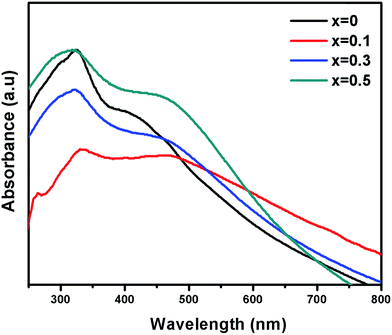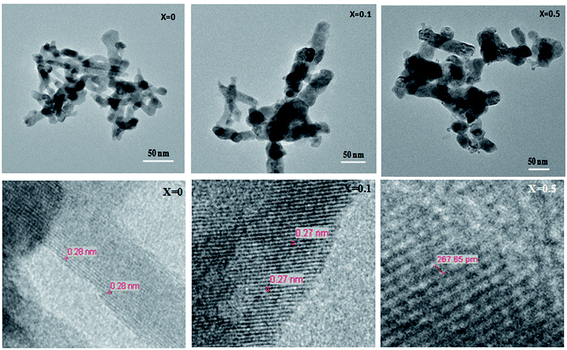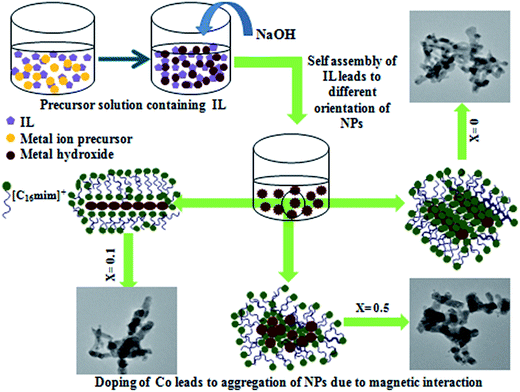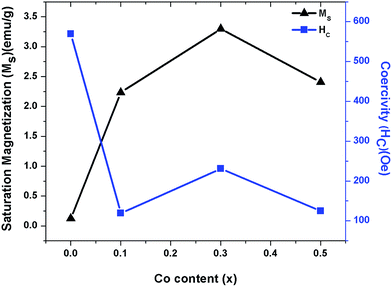Ionic liquid assisted nanofabrication of ferromagnetic Co-doped La–Ce ferrites†
Preet Shikha,
Tejwant Singh Kang* and
B. S. Randhawa*
Department of Chemistry, UGC-Centre for advanced Studies-I, Guru Nanak Dev University, Amritsar-143005, India. E-mail: balwinderrandhawa@gmail.com; tejwantsinghkang@gmail.com; Fax: +91 183 225820; Tel: +91 183 2258802 ext. 3207
First published on 27th October 2015
Abstract
Co(II) doped La–Ce ferrite nanoparticles (NPs) (La0.9Ce0.1Fe1−xCoxO3) have been prepared via a hydrothermal route using an ionic liquid surfactant (1-hexadecyl-3-methyl imidazolium chloride, [C16mim][Cl]) as a structure directing agent. The synthesized NPs have been characterized using XRD, Raman and IR spectroscopic techniques for structural elucidation. XRD studies revealed the formation of a mixed orthorhombic and rhombohedral phase with Co doping. The idea of distortion in the crystal structure of the prepared NPs has been formed due to a shift in the XRD peaks along with a change in the interplanar distance due to the incorporation of the dopant. UV-Vis studies indicated modification in the optical properties of La–Ce ferrites upon doping with Co. Scanning (SEM) and transmission electron microscopy (TEM) have shed light on the size and morphology of the prepared NPs. The doped NPs have been established to be ferromagnetic in nature as revealed by magnetic studies.
1. Introduction
The phenomenon of doping has increased interest in material science and in general, as it leads to materials with superior physico-chemical properties as compared to those of undoped nanomaterials. The unique characteristics of transition metal ions such as variable oxidation states, partially filled d-orbitals and their magnetically active nature make them suitable dopants in various inorganic oxides.1 The quality and quantity of the dopant significantly affect the physico-chemical properties of the doped nanomaterials. LaFeO3 nanoparticles (NPs) with a perovskite structure have been extensively investigated as powerful candidates for their application in diverse technical avenues such as in sensors, as magnetic materials, as catalysts, in solid oxide fuel cells and as electrode materials etc.2–16 Due to their flexible crystallographic structure, it is easy to incorporate various dopants to modulate their physico-chemical properties.17 In this regard, reports are available in the literature, where metal ions of different groups like alkali, alkaline earth and transition metals have been incorporated in LaFeO3 to modulate its physico-chemical properties.18–27 Most of the reports mentioned above generally discuss the improvement in their catalytic and sensing behavior, however studies regarding modulation or improvement in their magnetic behavior with doping are rarely available in the literature.28–33 On the other hand, numerous synthesis routes have been exploited to synthesize nanocrystalline LaFeO3, which include the solid state reaction of a metal oxide, a co-precipitation route, a precursor method, a sol–gel and hydrothermal method.34–38 Hydrothermal synthesis is one of the techniques employed for the synthesis of nanomaterials where the nucleation, growth and aging of the NPs can be controlled.38 There are, some reports existing in the literature, where the synthesis of pure or doped LaFeO3 materials using the hydrothermal route has been carried out. For example Ponpandian et al. synthesized photocatalytically active LaFeO3 nanostructures of different morphologies using a facile hydrothermal process39 and in another report dendritic LaFeO3 nanostructures for the selective determination of dopamine have also been synthesized via a surfactant (CTAB) assisted hydrothermal route.40 Similar work has been performed to obtain photocatalytically active microspheres composed of LaFeO3 NPs using a hydrothermal method.41 Regarding doped LaFeO3, Feng et al. reported the hydrothermal synthesis of LaFe1−xCrxO3 to study its composition dependent magnetic properties.42 Dai et al. evaluated the catalytic activity for toluene combustion by porous LaFeO3 synthesized via a glucose assisted hydrothermal route43 Nowadays, a new class of surfactants called ionic liquid surfactants (ILSs) is gaining immense scientific attraction due to their better surface activity and unique physico-chemical properties compared to conventional surfactants.44,45 In this regard, our research group is also engaged in the synthesis and characterization of a variety of ILSs.46–48 ILSs have been used as a soft template under hydrothermal conditions for controlling the size and morphology of NPs.49–51 Although there are many reports regarding the synthesis of LaFeO3 via a hydrothermal route using different structure directing agents, there are no reports regarding the synthesis of doped LaFeO3 NPs via a hydrothermal route using imidazolium based ILSs as structure directing templates. Even though the other methods like sol–gel, combustion, co-precipitation etc. as reported in the literature are equally effective and economical routes for the synthesis of pure and doped NPs, these methods generally give spherical NPs with insignificant anisotropy.19,52–58 Therefore, we have tried an ILS assisted hydrothermal route for the preparation of Co doped La–Ce ferrite NPs with the expectation of synthesizing anisotropic NPs with improved physico-chemical properties which exploit the surfactant like nature of the used ILS. Here in, we have synthesized and characterized Co(II) doped La0.9Ce0.1Fe1−xCoxO3 (x = 0, 0.1, 0.3, 0.5) NPs via a hydrothermal route using an ILS (1-hexadecyl-3-methyl imidazolium chloride, [C16mim][Cl]). To the best of our knowledge, this is the first report, where the presence of a small amount of Ce3+ ion along with the effect of Co doping at Fe-site in LaFeO3 NPs synthesized via a hydrothermal route using an ILS as a structure directing template is investigated. In this work, the impact of Co doping on the structural, morphological, optical and magnetic properties of the prepared NPs has been investigated in detail.2. Experimental
2.1 Methodology
For hydrothermal synthesis, stoichiometric quantities of La(NO3)3·6H2O, cerium(III) acetate, Fe(NO3)3·9H2O and Co(NO3)2·6H2O were dissolved in 0.05 M aqueous solution of ionic liquid, 1-hexadecyl-3-methyl imidazolium chloride [C16mim][Cl], which was synthesized and characterized using a well established protocol.59 The obtained mixture was sonicated for 30 min to get a clear solution followed by the addition of NaOH required for the complete precipitation of the metal ions. The resulting suspension was again sonicated for 15 min for appropriate mixing and then transferred to a teflon-lined stainless steel vessel and autoclaved at 180 °C for 24 h in an oven. The autoclave was then cooled naturally and the obtained product was washed with distilled water and ethanol to remove the excess base and excess surfactant. The obtained product was dried in air and then ground followed by calcination at 700 °C for 4–5 h.2.2 Characterization
X-ray diffractograms of the synthesized NPs (La0.9Ce0.1Fe1−xCoxO3) for phase analysis were recorded using a Rigaku Xpert Pro X-ray diffractometer provided with Cu Kα radiation (1.541 Å) in the 2θ range of 20–80° at a step size of 0.02°. The average particle size was calculated based on the XRD patterns using Scherrer’s formula. The Raman spectra were obtained for the prepared samples using a Renishaw Raman spectrophotometer equipped with a 488 and 514 nm Ar-ion laser in the range of 100–2000 cm−1. The UV-Vis spectra were recorded on a UV-spectrophotometer (UV-1800 SHIMADZU). Magnetic studies were carried out at room temperature in the applied magnetic field of −20 to +20 kOe using a Microsense EV-90 vibrating sample magnetometer. The surface morphology of the NPs was investigated by dispersing the sample in ethanol using a Zeiss Ultra 55-Limited edition scanning electron microscope. The transmission electron microscope (TEM) images were recorded using a JEM-2100 transmission electron microscope at a working voltage of 200 kV. The NPs were dispersed into ethanol using an ultrasonicator for the sample preparation of the TEM measurements. A drop of the dispersion was placed on a carbon coated grid (300 mesh) and excess solution was blotted off. The samples were dried at room temperature for 24 hours before measurement.3. Results and discussion
3.1 XRD analysis
Structural analysis of the prepared nanomaterials has been performed by obtaining the XRD patterns of the synthesized nanomaterials which are shown in Fig. 1(a). The XRD spectra of the pure and Co doped La0.9Ce0.1Fe1−xCoxO3 NPs indicate that the perovskite phase has an orthorhombic structure, which is consistent with pure LaFeO3 (JCPDS no. 37-1493). From the XRD studies, a change in the interplanar (d) value with Co doping for the main (121) peak has been observed, which suggests a change in the crystal lattice. Here a transition from the orthorhombic to rhombohedral phase is assumed to occur as is also reported by several other researchers.23,60 Therefore, the newly formed phase of the doped samples is assumed to be a mixture of rhombohedral and orthorhombic phases. The main diffraction peak (121) in the XRD patterns of the Co doped samples (x = 0.3, 0.5) shows a slight doublet, which is a characteristic signal of a rhombohedral structure23 as shown in Fig. 1(b), thus confirming the assumption. The average crystallite size of the obtained NPs has been calculated using Scherrer’s formula and is given in Table 1. As can be seen from Table 1, Co doping exerts a remarkable effect on the crystallite size, which decreases from 23 to 15 nm upon the incorporation of Co2+ ions. The decrease in the crystallite size with Co substitution can be attributed to the lower valence state of Co2+ than Fe3+, which can lead to a charge imbalance. This charge imbalance is compensated for by the formation of oxygen vacancies or a change in the valency of the metal ions (Fe3+/Fe4+ or Co2+/Co3+) leading to the hindered growth of the NPs.61,62 Furthermore, in addition to broadening, a significant shift of the XRD peaks towards a higher 2θ value has been observed. This can be explained on the basis that the replacement of smaller Fe3+ ions by larger Co2+ ions, results in the transformation of the orthorhombic structure to the rhombohedral structure or the distortion of the octahedral coordination.63 A small peak of the La2O3 phase appears in the XRD spectra of undoped La–Ce ferrite, which progressively disappears with Co doping. This suggests that the presence of Co2+ may stabilize the perovskite phase due to the formation of other rhombohedral phases of LaCoO3 in addition to LaFeO3. It has been observed that the nature and quantity of the dopant can modulate the structural parameters of the synthesized nanomaterials.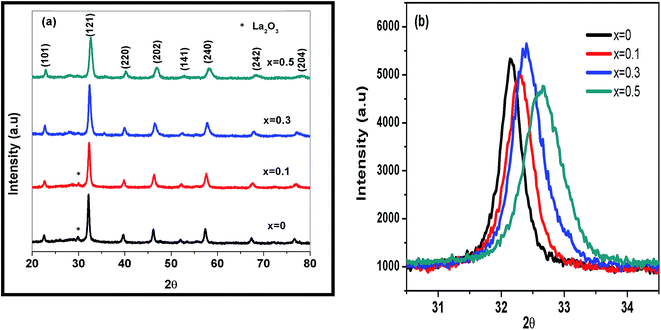 | ||
| Fig. 1 (a) XRD patterns of Co doped La0.9Ce0.1Fe1−xCoxO3 and (b) enlarged view of the (121) diffraction peak. | ||
| Co content (x) in La0.9Ce0.1Fe1−xCoxO3 | Average crystallite size from XRD (nm) | Particle size from TEM (nm) | Saturation magnetization (MS) (emu g−1) | Remnant magnetization (MR) (emu g−1) | Coercivity (HC) (Oe) |
|---|---|---|---|---|---|
| 0.0 | 23.1 | 15–25 | 0.123 | 0.0075 | 569.4 |
| 0.1 | 18.2 | 25–35 | 2.233 | 0.1489 | 119.4 |
| 0.3 | 15.8 | — | 3.297 | 0.7727 | 231.0 |
| 0.5 | 15.2 | 30–40 | 2.403 | 0.3187 | 124.9 |
3.2 FTIR & Raman spectroscopic studies
The FTIR spectra of the prepared NPs are displayed in Fig. 2. The spectra depict strong and broad vibrational bands at ∼572 and ∼430 cm−1, which are attributed to the antisymmetric stretching of Fe–O (ν1) and O–Fe–O deformation vibration (ν2), respectively, of FeO6 in an octahedral unit of perovskite ABO3.64 The exact position of the vibrational band could not be obtained due to the broadening of the bands, which can be due to both the Fe–O and Co–O stretching vibration in the range of 550–650 cm−1.63 The region of 1200–1800 cm−1 can be ascribed to carbonates and the bending vibration of bound water molecules, which were present on the surface due to the adsorption of CO2 and H2O.65 The absorption of CO2 indicates the basic nature of the surface of the synthesized samples. As can be seen in Fig. 2, with Co2+ substitution, a slight shift of the peak (550–650 cm−1) towards a higher wavenumber is observed with decreased broadening thus indicating structural distortion upon the introduction of Co2+ ions which affects the Fe–O bond strength.63 The decreased broadening at x = 0.5 shows that the Co–O stretching frequency becomes prominent at higher doping when compared to Fe–O or O–Fe–O.On the other hand, Raman spectroscopy is a powerful technique, which provides a chemical fingerprint of a specific compound or material. Most of the metal oxides show metal–oxygen vibration frequencies in the range of 200–1000 cm−1, where Raman spectroscopy may clearly be the choice over FTIR spectroscopy. The effect of the substitution of Co in La–Ce ferrites is expected to induce some structural defects, which can be easily analyzed using Raman studies. Fig. 3(a) and (b) show the Raman spectra of the Co doped La–Ce ferrite NPs by using a laser of wavelength 514 and 488 nm, respectively. The undoped La–Ce ferrite shows bands at 148, 222, 287, 422, 540 and 643 cm−1 which are in agreement with the literature.66,67 At a low content of Co2+ (x = 0.1), the number of Raman bands has been found to decrease due to the merging of peaks and a broad band in the region of 400–800 cm−1 with increased intensity around 630 cm−1, as compared to that of the undoped La–Ce NPs. This supports the substitution of Co2+ ions in the lattice of LaFeO3. The increase in the intensity of Raman bands with slight doping (x = 0.1) can be the result of substitutional disorder, which may cause bond length fluctuation.68 This suggests that Co2+ is affecting the oxygen tilt and hence, the stretching and bending modes of vibration. At higher doping of Co (x = 0.3, 0.5), we could not observe any Raman bands with the 514 nm Ar ion laser, but with the 488 nm laser, a less intense and broadened band around 630 cm−1 appeared. This behavior can be due to the fluorescence effect at the excitation wavelength of 488 nm or can be attributed to doping effects, which cause structural disorder. A Raman band in the vicinity of 630 cm−1 due to two phonons or impurity-related scattering is frequently observed in the perovskite-type structure.69 Structural modifications in the crystal lattice by Co substitution as revealed by the XRD studies can also be examined using Raman studies. As can be seen from the spectra, the doped samples show a somewhat different behavior than that of the undoped La–Ce ferrite NPs. Thus from the XRD, FTIR and Raman studies, it has been observed that Co doping in La–Ce ferrites leads to structural distortion either by a change in the valence state or creating oxygen deficiency. The change in the physico-chemical properties induced by Co doping in La–Ce ferrite are also reflected in various studies as discussed in the later sections.
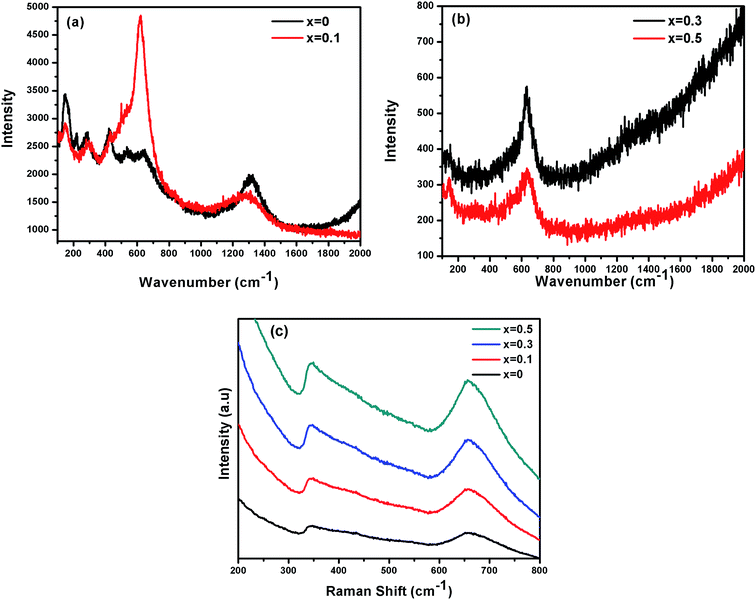 | ||
| Fig. 3 Raman spectra of the Co doped La–Ce ferrite nanoparticles at an excitation wavelength of (a) 514 nm, (b) 488 nm and (c) 785 nm. | ||
To have better insights and a proper comparison of the Raman spectra, the Raman spectra of the Co doped La–Ce ferrite NPs have been obtained at the excitation wavelength of 785 nm and are shown in Fig. 3(c). The samples show different behaviors than those observed at the excitation wavelength of 488 and 514 nm. Here, the intensity of the Raman bands also increases with Co doping along with prominent broadening with a slight shift of the bands towards a lower frequency, which could be due to the decrease in the average particle size with Co doping. This increased line width of the bands in the spectra with doping can be attributed to substitutional disorder or phonon scattering from randomly distributed cations in the lattice. The distortion of bond angles may also destroy the long range order but nearest neighbor interactions are affected and lead to a shift in vibrational frequency.68
3.3 UV-Vis studies
UV-Vis studies have been carried out on the Co-doped La–Ce ferrite NPs to explore the electronic properties and absorbance behavior of the synthesized samples. Fig. 4 shows that all the NPs show absorbance in the UV-Vis region in the range of 250–580 nm with a prominent band centered at 325 and 470 nm. The electronic transition from the valence band to the conduction band (O2p → Fe3d) is mainly responsible for a strong absorption band in perovskite type oxides.69,70 With Co doping, a red shift mainly in the visible region (from 426 to 475 nm) of the absorption spectra has been observed, which indicates that doping leads to a change in the optical properties of the synthesized NPs. The slight red shift in the absorption spectra can be correlated with a decrease in the band gap with doping. Thus the decrease in the band gap with Co doping in La–Ce Ferrites can be exploited for photocatalytic and sensing applications by harvesting more photons of light to excite the electrons from the valence band to the conduction band.3.4 Morphological studies
Fig. 5 shows the SEM images of the synthesized pure and Co doped La–Ce ferrite NPs. The morphology of the obtained sample (x = 0) appeared to be a mixture of aggregated rod-like and spherical structures. The SEM images of the Co doped samples don’t indicate a clear morphology because of some aggregation due to the samples’ enhanced magnetic nature when compared to that of the undoped NPs as established from the magnetic studies discussed later (Section 3.5). However, the TEM images provide a clear view of the shape and size of the Co doped NPs as shown in Fig. 6. The shape of the undoped La–Ce ferrite NPs (x = 0) appears to be an interconnecting rod like assembly of spherical NPs as can be seen from Fig. 6. The change in the morphological properties of the prepared nanomaterials could be due to the effect of the concentration of the precursor or template. To gain insight into this phenomenon, different concentrations of the ILS (0, 10, 50 and 200 mM) have been employed at a constant concentration of the precursor (3 mmol). The TEM images of the thus obtained NPs are provided in Fig. 7. It has been found that in the absence of the ILS the obtained La–Ce ferrite NPs show a spherical morphology with aggregation, however, at low concentrations of the ILS (10 mM), mainly spherical NPs clubbed together via sheet like architectures, have been obtained. At the higher content of the ILS i.e. at 50 and 200 mM, a network of elongated rod like NPs along with some spherical NPs has been obtained. This shows that with the increase in concentration of the ILS, a change in morphology from spherical to rod like along with the varying extent of aggregation of the NPs takes place and the morphology of the prepared NPs is dominantly controlled by the presence of a template. No significant change in the XRD pattern has been obtained, but a slight increase in the average crystallite size of the NPs with the increase in the concentration of the ILS has been observed as can be seen from Table S1 (ESI†). Thus we have concluded that the presence of the ILS in the reaction medium creates some anisotropy in the NPs, where aggregated spherical NPs are observed in the absence of the ILS. Co doping (at a fixed concentration of ILS at 50 mM) in the La–Ce ferrite NPs does not significantly influence the morphology of the prepared NPs, however, it exerts an effect on the physico-chemical properties of the prepared NPs. The NPs obtained at the lower content of the Co2+ ions (x = 0.1) show some dendrite/rod like morphology, which can be a result of the templating effect of the ILS. The particles are interacting with each other due to their weak magnetic nature. For a higher content of the Co-doped samples (x = 0.5), there is an increase in the aggregation of the nanomaterials as observed from the TEM analysis. | ||
| Fig. 7 TEM images of the undoped La–Ce ferrite NPs obtained from different conc. of the ILS (a) 0 mM, (b) 10 mM and (c) 200 mM. | ||
The morphology and size of the NPs are generally controlled by various internal and external factors. The use of surfactants has been commonly employed for controlling the morphology and size of the NPs. Among them IL based surfactants having an imidazolium moiety have a unique directional ability due to their extended hydrogen bond network. In this work, we have used [C16mim][Cl] as the surfactant along with Co doping to synthesize and investigate its effect on the morphology and physico-chemical properties of the obtained NPs. Scheme 1 illustrates the formation mechanism of the pure and doped NPs. The strong tendency of [C16mim][Cl] to self-aggregate into ordered structures, which have a large steric hindrance thus can provide space for the oriented arrangement of growing NPs in a 2D direction.71 The self-assembled structures of the ILS such as micelles present in solution templating the formation of the NPs are expected to become closer due to the magnetic interaction between the NPs in an elongated fashion. The growth of the NPs here takes place in such 2D structures, where the aggregation of the NPs mediated by the ILS takes place resulting in a rod like morphology having some spherical structure. The shape of the micelles formed by the ILS may be affected by the addition of the Co2+ ions as a dopant similar to that of the additive in an ionic surfactant solution,72 which could influence the growth of the NPs and thus can affect the morphology of the obtained NPs. The self-assembled NPs form an interconnected network on calcination, which can be due to magnetic interaction among the doped NPs as observed in the SEM and TEM images. The presence of Co2+ in the sample may hinder the growth of the NPs as observed from the decrease in the average crystallite size from the XRD studies and thus a complete rod like network has not been observed as obtained for the undoped NPs. The doping of Co2+ in the La–Ce ferrite NPs at a fixed concentration of ILS (50 mM) leads to the aggregation of rod and spherical NPs due to the magnetic interaction among the NPs, thus a cluster like network has been observed in the TEM images of the doped samples. The particle size and morphology of the obtained samples synthesized by our method have been compared with those from other methods in the literature and are displayed in Table 2. The EDX analysis of the pure and doped NPs as shown in Fig. 8 confirms the presence of La, Fe, Ce, Co and O elements in appropriate amounts. The HRTEM images shown in Fig. 6 provide further information about the change in the interplanar distance with Co doping in the La–Ce ferrite NPs. The lattice fringe spacing of the undoped NPs is 0.28 nm, which is well indexed with the (121) plane of the orthorhombic structure. With Co doping a slight decrease from 0.28 nm to 0.267 nm in the “d” spacing of the lattice fringes has been observed, which can be correlated with the XRD studies thus suggesting some structural distortion with doping.
| Sr. no. | Sample | Synthetic route | Template/surfactant | Morphology obtained | Particle size (nm) | Ref. |
|---|---|---|---|---|---|---|
| 1 | La–Ce ferrite | Hydrothermal route | ILS [C16mim][Cl] | Interconnecting rods | 15–25 | This work |
| 2 | LaFeO3 | Hydrothermal route | ILS [C16mim][Cl] | Spherical and rods | 18–28 | This work (ESI) |
| 3 | LaFeO3 | Glycine combustion | — | Irregular spherical | 57–59 | 52 |
| 4 | LaFeO3 | Gel-based auto combustion | — | Agglomerated spherical | 60–80 | 53 |
| 5 | LaFeO3 | Reverse microemulsion | Aerosol-OT, AOT | Spherical | 24.65 | 56 |
| 6 | La–Ce ferrite | Sol–gel | — | Spherical | 25–37 | 19 |
| 7 | La–Ce ferrite | Combustion and co-precipitation | — | Spherical | 24–27 | 54 |
| 8 | LaFeO3 | Sonochemical | — | Agglomerated particles | 30 | 55 |
| 9 | LaFeO3 | Non-aqueous | Benzyl alcohol | 57 | ||
| 10 | LaFeO3 | Polymerized-complex | — | Irregular spherical | 44–74 | 58 |
3.5 Magnetic studies
The magnetic properties of the Co doped La–Ce ferrite NPs at room temperature have been investigated using a vibrating sample magnetometer. LaFeO3 is generally antiferromagnetic (canted) in nature. In LaFeO3, a superexchange interaction between two Fe3+ ions through the intervening oxide ions results in its antiferromagnetic nature, however due to the slight canting of spins, weak ferromagnetism has been observed.73 The antiferromagnetic/weak ferromagnetic nature of the LaFeO3 NPs limits their application in magnetic devices, therefore it is necessary to increase their magnetization. Their magnetic properties are usually influenced by the choice of synthetic route and type of doping.28–33 The effect of Co doping on the magnetic properties of the synthesized nanomaterials is shown in Fig. 9(a) and (b). The presence of a hysteresis loop indicates the existence of weak ferromagnetic character at room temperature. Various magnetic parameters such as coercivity (HC), remnant (MR) and saturation (MS) magnetization as a function of the Co content are provided in Table 1. Co doping in La–Ce ferrite leads to a significant enhancement in various magnetic parameters up to a certain extent i.e. up to x = 0.3. A drastic change has been observed in MS with Co doping (3.297 emu g−1) when compared to that of the undoped ferrite sample (0.123 emu g−1). The probable reason for such a behavior seems to be structural distortion caused by doping, which weakens the superexchange interactions by changing the canting angle.74 Particle size reduction with doping can also affect the magnetic properties by increasing the uncompensated spins on the surface.75 The addition of Co up to a certain extent (x = 0.3) enhances the magnetic parameters (MR and MS), which further go on to decrease at higher doping. Suitable reasons for this observation are that with the addition of Co ions, the superexchange interactions among Fe3+–O–Fe3+ are replaced by Fe3+–O–Co2+ at intermediate doping. Due to the different electronic arrangement of Co and Fe ions, complete cancellation of their spins is prevented and thus the sample shows enhanced magnetization compared to the undoped sample at room temperature.76,77 But at higher doping (x = 0.5), in addition to the LaFeO3 phase, the formation of some of the LaCoO3 phase takes place, as revealed by the XRD studies, which has Co2+–O–Co2+/Co3+–O–Co3+ interactions that can be couple antiferromagnetically, leading to a slight reduction in MR and MS.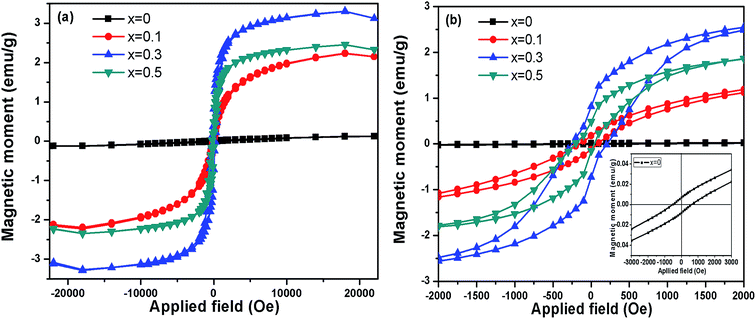 | ||
| Fig. 9 (a) Hysteresis loops of Co doped La–Ce ferrite nanoparticles at room temperature (b) magnified view of (a) in lower applied field. | ||
The variation of HC as a function of the Co content in La–Ce ferrites is shown in Fig. 10. The undoped NPs show the highest HC, which first decreases and then increases up to a certain extent of doping (x = 0.3). The large HC observed in the undoped La–Ce NPs can be attributed to the shape anisotropy as observed in the TEM images, which has some interconnecting rod like appearance thus resulting in higher HC![[thin space (1/6-em)]](https://www.rsc.org/images/entities/char_2009.gif) 78 whereas the La–Ce ferrite NPs synthesized by our group via combustion and co-precipitation show low HC.54 This shows some anisotropic effect induced by the ILS on the synthesized NPs. The structural transition at higher doping of Co (x = 0.5) can also not be ruled out as a reason behind the decrease in various magnetic parameters as revealed from the XRD studies. Thus the enhanced magnetization of LaFeO3 type oxides by doping can be utilized for a variety of applications, which can further be controlled under the application of a magnetic field.
78 whereas the La–Ce ferrite NPs synthesized by our group via combustion and co-precipitation show low HC.54 This shows some anisotropic effect induced by the ILS on the synthesized NPs. The structural transition at higher doping of Co (x = 0.5) can also not be ruled out as a reason behind the decrease in various magnetic parameters as revealed from the XRD studies. Thus the enhanced magnetization of LaFeO3 type oxides by doping can be utilized for a variety of applications, which can further be controlled under the application of a magnetic field.
Furthermore, the motive to use the ILS is to provide some directional property to the synthesized NPs, which generally is not found with other methods like the citrate gel and combustion method etc., where mostly small aggregated spherical NPs have minor or insignificant anisotropy as observed from the literature survey.52–58 However due to the lack of literature regarding the magnetic studies of Co doped La–Ce ferrite NPs an exact comparison could not be done.
4. Conclusion
The impact of Co doping on the physico-chemical properties of La–Ce ferrite NPs synthesized via a hydrothermal route using an ILS (1-hexadecyl-3-methyl imidazolium chloride, [C16mim][Cl]) has been investigated. The information obtained from XRD and IR studies indicates a structural transition with a decrease in the average crystallite size (15–23 nm) with Co doping due to a charge imbalance. The amount of Co doping has been found to induce structural distortion and thus control the physico-chemical properties of the La–Ce ferrite NPs. The obtained ferrites show a mixture of rod and spherical NPs thus giving an appearance of a partial dendrite like structure. Magnetic parameters such as saturation magnetization were significantly enhanced (from 0.123 to 3.297 emu g−1) with Co doping (x = 0.3) when compared to those of undoped ferrite NPs due to more uncompensated surface spins on the surface of the NPs and a different magnetic moment of the dopant. In a nutshell, the physico-chemical properties, specifically the magnetic properties of La–Ce ferrite NPs, have been significantly improved with Co doping synthesized via an ILS-assisted hydrothermal approach.Acknowledgements
The authors are very thankful to the Council of Scientific and Industrial Research (CSIR), New Delhi, India, vide Project number 01/(2774)/14-EMR-II and the Defence Research and Development Organization (DRDO), project number ERIP/ER/1003912/M/01/1417, New Delhi, India for financial support.References
- R. H. Crabtree, The Organometallic Chemistry of the Transition Metals, John Wiley and Sons, April 2009 Search PubMed.
- H. Obayashi, Y. Sakurai and T. Gejo, J. Solid State Chem., 1976, 17, 299–303 CrossRef CAS.
- P. Song, H. W. Qin, L. Zhang, K. An, Z. J. Lin, J. F. Hu and M. H. Jiang, Sens. Actuators, B, 2005, 104, 312–316 CrossRef CAS.
- T. V. Choudhary, S. Banerjee and V. R. Choudhary, Appl. Catal., A, 2002, 234, 1–23 CrossRef CAS.
- L. G. Tejuca, J. Less-Common Met., 1989, 146, 261–270 CrossRef CAS.
- Y. Teraoka, M. Yoshimatsu, N. Yamazoe and T. Seiyama, Chem. Lett., 1984, 13, 893–896 CrossRef.
- H. Falćon, M. J. Martinez-Lope, J. A. Alonso and J. L. G. Fierro, Appl. Catal., B, 2000, 26, 131–142 CrossRef.
- O. Mihai, D. Chen and A. Holmen, Ind. Eng. Chem. Res., 2011, 50, 2613–2621 CrossRef CAS.
- O. Mihai, D. Chen and A. Holmen, J. Catal., 2012, 293, 175–185 CrossRef CAS.
- F. J. Berry, X. Ren, J. R. Ganced and J. F. Marco, Hyperfine Interact., 2004, 156, 335–340 CrossRef.
- Q. Zhang and F. Saito, J. Mater. Sci., 2001, 36, 2287–2290 CrossRef CAS.
- S. Nakayama, J. Mater. Sci., 2001, 36, 5643–5648 CrossRef CAS.
- Q. Ming, M. D. Nersesyan, A. Wagner, J. Ritchie, J. T. Richardson, D. Luss, A. J. Jacobson and Y. L. Yang, Solid State Ionics, 1999, 122, 113–121 CrossRef CAS.
- T. Arakawa, H. Kurachi and J. Shiokawa, J. Mater. Sci., 1985, 20, 1207–1210 CrossRef CAS.
- Y. Shimizu, M. Shimabukuro, H. Arai and T. Seiyama, Chem. Lett., 1985, 14, 917–920 CrossRef.
- G. Martinelli, M. C. Carotta, M. Ferroni, Y. Sadaoka and E. Traversa, Sens. Actuators, B, 1999, 55, 99–110 CrossRef CAS.
- A. Manthiram, J. H. Kim, Y. N. Kim and K. T. Lee, J. Electroceram., 2011, 27, 93–107 CrossRef CAS.
- Y. Chen, H. M. Yuan, G. Tian, G. H. Zhang and S. H. Feng, J. Solid State Chem., 2007, 180, 167–172 CrossRef CAS.
- X. P. Xiang, L. H. Zhao, B. T. Teng, J. J. Lang, X. Hu, T. Li, Y. A. Fang, M. F. Luo and J. J. Lin, Appl. Surf. Sci., 2013, 276, 328–332 CrossRef CAS.
- L. Hou, G. Sun, K. Liu, Y. Li and F. Gao, J. Sol-Gel Sci. Technol., 2006, 40, 9–14 CrossRef CAS.
- M. Ghasdia, H. Alamdaria, S. Royerb and A. Adnot, Sens. Actuators, B, 2011, 156, 147–155 CrossRef.
- Y. Sun, S. S. Hla, G. J. Duffy, A. J. Cousins, D. French, L. D. Morpeth, J. H. Edwards and D. G. Roberts, Int. J. Hydrogen Energy, 2011, 36, 79–86 CrossRef CAS.
- M. M. Natile, F. Poletto, A. Galenda, A. Glisenti, T. Montini, L. D. Rogatis and P. Fornasiero, Chem. Mater., 2008, 20, 2314–2327 CrossRef CAS.
- M. V. Kuznetsov, Q. A. Pankhurst, I. P. Parkinc and Y. G. Morozova, J. Mater. Chem., 2001, 11, 854–858 RSC.
- S. Dong, K. Xu and G. Tian, J. Mater. Sci., 2009, 44, 2548–2552 CrossRef CAS.
- H. Wu, R. Hu, T. Zhou, C. Li, W. Meng and J. Yang, CrystEngComm, 2015, 1, 3859–3865 RSC.
- H. A. Medkhali, K. Narasimharao, S. N. Basahel and M. Mokhtar, J. Membr. Sep. Technol., 2014, 3, 206–212 CrossRef.
- R. J. Choudhary, R. Kumar, M. W. Khan, J. P. Srivastava, S. I. Patil, S. K. Arora and I. V. Shvets, Appl. Phys. Lett., 2005, 87, 132104 CrossRef.
- L. Yuan, K. Huang, C. Hou, W. Feng, S. Wang, C. Zhou and S. Feng, New J. Chem., 2014, 38, 1168 RSC.
- M. A. Ahmed, N. Okasha and B. Hussein, J. Alloys Compd., 2013, 553, 308–315 CrossRef CAS.
- D. V. Karpinsky, I. O. Troyanchuk, K. Bärner, H. Szymczak and M. Tovar, J. Phys.: Condens. Matter, 2005, 17, 7219–7226 CrossRef CAS.
- Y. Janbutrach, S. Hunpratub and E. Swatsitang, Nanoscale Res. Lett., 2014, 9, 498 CrossRef PubMed.
- K. Mukhopadhyay, A. S. Mahapatra and P. K. Chakrabarti, J. Magn. Magn. Mater., 2013, 329, 133–141 CrossRef CAS.
- M. Shi, N. Liu, Y. D. Xu, C. Wang, Y. P. Yuan, P. Majewski and F. Aldinger, J. Mater. Process. Technol., 2005, 169, 179–183 CrossRef CAS.
- J. J. Liang and H. S. Weng, Ind. Eng. Chem. Res., 1993, 32, 2563–2572 CrossRef CAS.
- S. Royer, F. Bérubé and S. Kaliaguine, Appl. Catal., A, 2005, 282, 273–284 CrossRef CAS.
- A. E. Giannakas, A. K. Ladavos and P. J. Pomonis, Appl. Catal., B, 2004, 49, 147–158 CrossRef CAS.
- K. Byrappa and T. Adschiri, Prog. Cryst. Growth Charact. Mater., 2007, 53, 117–166 CrossRef CAS.
- S. Thirumalairajan, K. Girija, N. Y. Hebalkar, D. Mangalaraj, C. Viswanathan and N. Ponpandian, RSC Adv., 2013, 3, 7549–7561 RSC.
- S. Thirumalairajan, K. Girija, V. Ganesh, D. Mangalaraj, C. Viswanathan and N. Ponpandian, Cryst. Growth Des., 2013, 13, 291–302 CAS.
- S. Thirumalairajan, K. Girija, V. Ganesh, D. Mangalaraj, C. Viswanathan, A. Balamurugan and N. Ponpandian, Chem. Eng. J., 2012, 209, 420–428 CrossRef CAS.
- W. Hu, Y. Chen, H. Yuan, G. Zhang, G. Li, G. Pang and S. Feng, J. Solid State Chem., 2010, 183, 1582–1587 CrossRef CAS.
- K. Ji, H. Dai, J. Deng, L. Song, S. Xie and W. Han, J. Solid State Chem., 2013, 199, 164–170 CrossRef CAS.
- X. Liu, X. Duan, Q. Qin, Q. Wang and W. Zheng, CrystEngComm, 2013, 15, 3284–3287 RSC.
- A. Z. Hezave, S. Dorostkar, S. Ayatollahi, M. Nabipour and B. Hemmateenejad, Colloids Surf., A, 2013, 421, 63–71 CrossRef CAS.
- R. Kamboj, P. Bharmoria, V. Chauhan, G. Singh, A. Kumar, S. Singh and T. S. Kang, Phys. Chem. Chem. Phys., 2014, 16, 26040–26050 RSC.
- R. Kamboj, P. Bharmoria, V. Chauhan, S. Singh, A. Kumar, V. S. Mithu and T. S. Kang, Langmuir, 2014, 30, 9920–9930 CrossRef CAS PubMed.
- V. Chauhan, R. Kamboj, S. P. S. Rana, T. Kaur, G. Kaur, S. Singh and T. S. Kang, J. Colloid Interface Sci., 2015, 446, 263–271 CrossRef CAS PubMed.
- X. Bai, L. Zheng, N. Li, B. Dong and H. Liu, Cryst. Growth Des., 2008, 8, 3840–3846 CAS.
- J. Ma, X. Liu, J. Lian, X. Duan and W. Zheng, Cryst. Growth Des., 2010, 10, 2522–2527 CAS.
- K. J. Holmberg, J. Colloid Interface Sci., 2004, 274, 355–364 CrossRef CAS PubMed.
- Y. Wang, J. Zhu, L. Zhang, X. Yang, L. Lu and X. Wang, Mater. Lett., 2006, 60, 1767 CrossRef CAS.
- H. Shen, G. Cheng, A. Wu, J. Xu and J. Zhao, Phys. Status Solidi A, 2009, 206, 1420–1424 CrossRef CAS.
- P. Shikha, T. S. Kang and B. S. Randhawa, J. Alloys Compd., 2015, 625, 336–345 CrossRef CAS.
- M. Sivakumar, A. Gedanken, W. Zhong, Y. H. Jiang, Y. W. Du, I. Brukental, D. Bhattacharya, Y. Yeshurun and I. Nowik, J. Mater. Chem., 2004, 14, 764–769 RSC.
- R. Abazari and S. Sanati, Superlattices Microstruct., 2013, 64, 148–157 CrossRef CAS.
- W. Yang, R. Zhang, B. Chen, N. Bion, D. Duprez, L. Hou, H. Zhang and S. Royer, Chem. Commun., 2013, 49, 4923–4925 RSC.
- S. Phokha, S. Pinitsoontorn, S. Maensiri and S. Rujirawat, J. Sol-Gel Sci. Technol., 2014, 71, 333–341 CrossRef CAS.
- K. R. Seddon, A. Stark and M. Torres, Pure Appl. Chem., 2000, 72, 2275–2287 CrossRef CAS.
- I. O. Troyanchuka, D. V. Karpinskiĭ, V. M. Dobryanskiĭ, Yu. A. Fedotova and H. Szymczak, J. Exp. Theor. Phys., 2005, 6, 1121–1126 CrossRef.
- Z. Wang, C. Chen, C. Feng, J. Wang, B. Zou, M. Zhao and F. Wu, Acta Phys.-Chim. Sin., 2008, 24, 375–378 CrossRef CAS.
- C. Feng, S. Ruan, J. Li, B. Zou, J. Luo, W. Chen, W. Dong and F. Wu, Sens. Actuators, B, 2011, 155, 232–238 CrossRef CAS.
- H. Cui, M. Zayat and D. Levy, J. Non-Cryst. Solids, 2006, 352, 3035–3040 CrossRef CAS.
- P. Jeevanandam, Y. Koltypin, O. Palchik and A. Gedanken, J. Mater. Chem., 2001, 11, 869–873 RSC.
- G. V. S. Rao, C. N. R. Rao and J. R. Ferraro, Appl. Spectrosc., 1970, 24, 436–445 CrossRef CAS.
- J. Feng, T. Liu, Y. Xu, J. Zhao and Y. He, Ceram. Int., 2011, 37, 1203–1207 CrossRef CAS.
- C. Jagadeeshwaran, A. P. Blessington Selvadurai, V. Pazhanivelu and R. Murugaraj, International Journal of Innovative Research in Science & Engineering, 2014, 2, 140–145 Search PubMed.
- R. S. Das and Y. K. Agrawal Vibrational, Spectroscopy, 2011, 57, 163–176 CAS.
- M. Popa, J. Frantti and M. Kakihana, Solid State Ionics, 2002, 154, 437–445 CrossRef.
- K. Li, D. Wang, F. Wu, T. Xie and T. Li, Mater. Chem. Phys., 2000, 64, 269–272 CrossRef CAS.
- (a) A. Taubert, Angew. Chem., Int. Ed., 2004, 43, 5380–5382 CrossRef CAS PubMed; (b) Y. Zhou and M. Antonietti, Adv. Mater., 2003, 15, 1452–1455 CrossRef CAS.
- M. J. Rosen, Surfactant and interfacial phenomena, John Wiley and Sons, New York, 2nd edn, 1989 Search PubMed.
- D. Treves, J. Appl. Phys., 1965, 36, 1033–1039 CrossRef CAS.
- W. S. Kim, Y. K. Jun, K. H. Kim and S. H. Hong, J. Magn. Magn. Mater., 2009, 321, 3262–3265 CrossRef CAS.
- L. Neel, C. R. Hebd. Seances Acad. Sci., 1961, 252, 4075 Search PubMed.
- S. Basu, S. K. M. Hossain, D. Chakravorty and M. Pal, Curr. Appl. Phys., 2011, 11, 976 CrossRef.
- W. S. Kim, Y. Kijun, K. H. Kim and S. H. Hong, J. Magn. Magn. Mater., 2009, 321, 3262 CrossRef CAS.
- H. W. Zhang, T. Y. Zhao, J. Zhang, C. B. Rong, S. Y. Zhang, B. G. Shen, L. Li and L. G. Zhang, J. Phys. D: Appl. Phys., 2003, 36, 1769–1772 CrossRef CAS.
Footnote |
| † Electronic supplementary information (ESI) available. See DOI: 10.1039/c5ra17174a |
| This journal is © The Royal Society of Chemistry 2015 |


